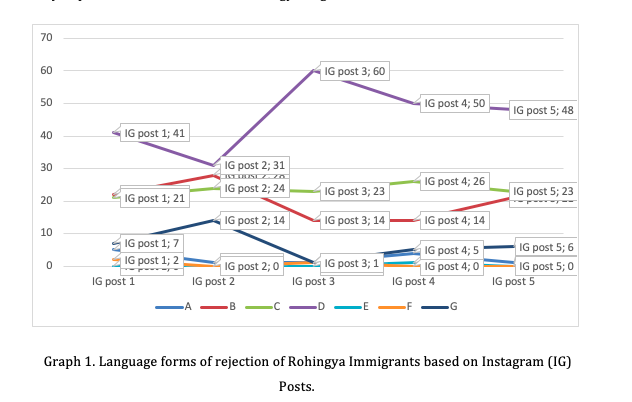- Rahmad Nuthihar Akademi Komunitas Negeri Aceh Bara
- Ramli Ramli Universitas Syiah Kuala
- Herman Rusli Universitas Syiah Kuala
- Ixsir Eliya Universitas Islam Negeri Fatmawati Bengkulu
- Sumaiyah Menjamin Fatoni University
Abstrak
This research examines the language forms of rejection by Instagram netizens regarding Rohingya in Aceh Province. This research is a mixed method by combining quantitative and qualitative. A quantitative approach is used to see the percentage of rejection forms, while a qualitative approach is used to describe in detail the forms of rejection language. Data collection was carried out using document analysis techniques with the data source being posts on the Instagram accounts @tercyduck.aceh, @kabaraceh, @acehworldtimenews, @tanyoe.acehtimur, and @infobandaaceh. 100 data were selected for each post with a total of 500 data. The results of this study concluded that the dominant form of rejection language used by netizens was the use of suggestions or other options were 46.46%. This proves that Instagram netizens have sympathy for Rohingya immigrants by providing solutions. Meanwhile, netizens’ firmness in rejecting Rohingya immigrants is proven by the finding that 0.20% of the language forms rejection with thanks as rejection. This research also found that technological developments have contributed to the addition forms of rejection’s language. We found new forms of rejection language, namely symbols or emoticons, metaphors, and hashtags to influence other Instagram users.
Introduction
The plight of Rohingya immigrants has escalated into a global concern. Malaysia and Indonesia have emerged as refugee destinations for the Rohingya ethnic minority (BBC, 2023; Ehmer & Kothari, 2021). Data of December 2023 showed that Indonesia has received a total of 1,600 Rohingya refugees. Their distribution spans multiple provinces, including Aceh Province, situated in the westernmost area. According to several media outlets, a group of Rohingya immigrants arrived in Aceh in 2009 (Abik, 2020). The total number of immigrants was 193 (Ehmer & Kothari, 2021; Robbins, 2020). The initial reception of Rohingya immigrants in Aceh was favorable due to their perceived status as victims of inter-ethnic strife in their home country (Usman et al., 2023). Nevertheless, over time, the population of Rohingya immigrants steadily grows (Islam, 2020; Sahana et al., 2019).
In recent months, there has been a significant increase in the rejection of Rohingya immigrants (Milton et al., 2017). Indeed, certain individuals went as far as to evict them. In addition to that, rejection frequently manifests itself on social media through the use of very critical and harsh words (Christakis & Fowler, 2013). The Acehnese people’s repudiation of the Rohingya ethnic group manifests not only through written content in social media posts but also through the dissemination of concise videos by social media users (Han, 2023). Sometimes, the videos employ severe language of rejection.
Seeing this phenomenon requires special attention from the government and related institutions (Gürtler, 2023). The imperative to rescue the Rohingya ethnic group is an undeniable reality from a humanitarian standpoint. However, it is equally crucial to acknowledge the widespread opposition from the general populace (Vincent & Mgaya, 2022).
The rejection of Rohingya immigrants is particularly intriguing to examine (Al Marjuk, 2022; Kipgen, 2019). In the Aceh context, the importance of expressing rejection can be understood for several reasons. Firstly, the people of Aceh have a reputation for readily accepting immigrants, as evidenced by historical records of ethnic groups from the Dutch, Portuguese, and Japanese visiting the region (Mukhlis & Rusli, 2023). Secondly, Aceh is renowned for upholding human values through its local wisdom (Yusuf et al., 2020). The presence of the Rohingya ethnic group in Aceh prompted many Acehnese individuals to reject their arrival, leading to the question of why this occurred.
In addition to the aforementioned reasons, this research holds significance due to the fact that the Rohingya crisis has gained global attention. Furthermore, it pertains to matters of humanitarian concern (Lusi Rahmawati Surun et al., 2022). This study primarily examines the expressions of rejection used by social media users in Aceh. In order to delimit the study’s focus, the data was sourced from users of the Instagram (IG) social networking platform. This study aims to examine the language manifestations of rejection as articulated by Instagram users from Aceh. Kartomihardjo (1990) put forth a hypothesis that serves as the basis for the study of rejection language. This theory categorizes rejection into seven distinct forms: (1) explicit refusal using the word ‘no’ or its equivalent, (2) providing reasons for the rejection, (3) employing terms or conditions as a substitute for outright rejection, (4) offering alternative suggestions or options, (5) expressing gratitude as a means of rejection, (6) using comments as a form of rejection, and (7) conveying rejection through nonverbal signals (Chang, 2009). Selecting a subject in the form of rejection language holds significance. The findings of this study can serve as guidance for the government and relevant stakeholders in addressing a prevalent issue within the community. Hence, this study aims to investigate and ascertain the existence of novel patterns or manifestations of language used to express rejection, given the antiquated nature of Kartomihardjo’s (1990) theory. This research aims to identify novel trends in technological advancements by analyzing the comments column, which serves as a new channel of communication that closely resembles spoken language. This is due to the concurrent nature of Instagram’s comment-reply feature, which renders it akin to vocal communication.
There has been very little research regarding forms of rejection language. The theories used to study forms of rejection language all refer to Kartomihardjo (1990). The theory put forward by Kartomihardjo (1990) is too old that the research results obtained by Busri and Massagun (2023) found that the seven forms of rejection language were applied by students when attending lectures. This is slightly different from research conducted by Hermaji (2011) who found that the pattern of forms of rejection was characterized by “Fixed Expression (UT) + Verb Marking the Act of Rejection + (Objective)”. Another form of rejection is carried out by the speaker by apologizing at the beginning. This is a form of rejection carried out in a more polite form (Mukhamdanah and Inayatusshalihah, 2020; Pratiwi and Ramdani, 2021).
The research conducted by the researchers above does not represent the entire rejection language. This is because the use of technology such as social media allows the creation of new types or forms of expressing rejection. In this research, we examine the form of rejection language used by netizens regarding the social issue of the arrival of Rohingya immigrants in Aceh Province. This research aims to find forms of rejection language to enrich theories relating to pragmatics.

